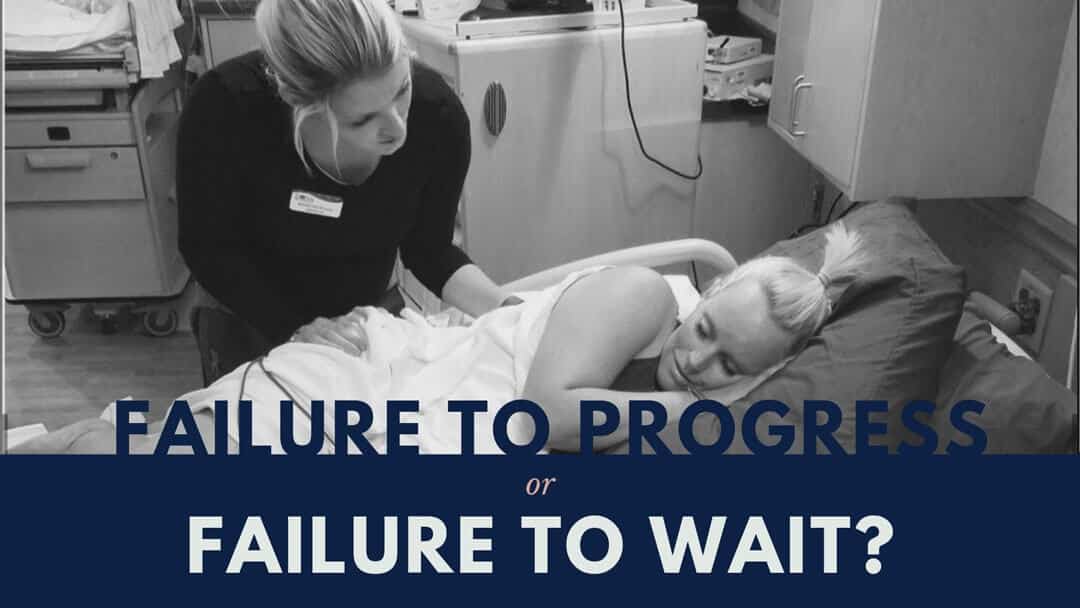Updated September 2025
There are many different reasons why women have C-sections, and there can even be multiple reasons from each birth.
Some reasons include having a large baby, baby’s position, fetal distress, infection, failure to progress, multiples, and more.
Today we are going to talk about one of the most common reasons we hear from our followers, which are similar to the reasons in our own operative reports.

What is Failure to Progress?
Failure to progress is typically “diagnosed” by a provider when a mother’s cervix does not make significant change after so many hours.
Historically, evidence has shown that many care providers do not give women the chance to progress in the first stage of labor (dilating from 0-10cm) or enough time to push the baby out when they reach complete.
In 2011, ACOG and SMFM (the Society for Maternal-Fetal Medicine) put out an updated definition on time limits for the first (dilation) and second (pushing) stages of labor.
The guideline says that a woman is not considered to be in active labor until six centimeters and cannot be termed as “failure to progress” until she is at least six centimeters dilated, her waters have ruptured, and no cervical change has been made in six hours of labor.
ACOG released an updated report in 2024 which reiterates the same guidelines above but also includes that these are “conditional recommendations” with “low quality evidence,” meaning “the balance of benefits and risks will vary depending on patient characteristics and their values and preferences. Individualized, shared decision making is recommended to help patients decide on the best course of action for them” (ACOG 2024).
Something that is essential to understand is that if there is ANY progress at all, that equals change. And, remember, labor progress is not just about cervical dilation.
Labor progresses through these six stages:
- The cervix moves from posterior to an anterior position
- The cervix ripens and softens
- The cervix effaces
- The cervix dilates
- The baby’s head rotates, flexes, and molds
- The baby descends, rotates further, and is born
What Causes Failure to Progress?
Often when labor stalls, there can be various reasons why, and knowing these reasons can help labor continue to progress on its normal path.
Induction
Induction may be chosen for a medical reason or simply because the mother decides she is ready to meet her baby. While there are several different types of induction, it’s important to understand that because the body isn’t always ready to begin labor, it can be a long process. It may take several hours or even days for labor to begin.
This doesn’t mean your body is failing to progress.
Water breaking prematurely
Although somewhat rare, your bag of waters may break or rupture slightly before labor begins (or in very early labor). When this happens, hormones are released that typically help labor progress. However, if the membranes rupture first, it can take a long time for the body to register that it’s time to begin labor.
Additionally, when this happens in early labor (when baby is still higher in the pelvis) baby may drop down in a wonky position.
Once waters are broken, providers typically start a “time clock,” in which they begin monitoring for signs of infection within 24 hours. If “nothing is happening,” they may jump to recommending a Cesarean.
Remember, it may take time for your body to catch up or realign baby after a premature rupture of membranes.
This does not mean your body is failing to progress.
Poor fetal position
Fetal positioning can have a big impact on the way a cervix changes. If a baby’s head is not applied to the cervix correctly, it can cause slow dilation. There are positions changes and movements that can help baby rotate, but it may take time.
This does not mean your body is failing to progress.
Failure to wait
Sometimes labor just takes time. It can be protracted by factors like scar tissue on the cervix, malpositioned baby, mother’s exhaustion or a mental hurdle. Understanding that a woman’s body is not a time clock and doesn’t have to follow exactly when a text book says is vital.
Being patient and letting labor begin on its own is ideal, and once labor begins, allowing and trusting the body to take its own course is best.
Ways to Help Avoid Failure to Progress
Before we leave you today, we want to drop some quick tips for avoiding a Cesarean due to “failure to progress:”
- Wait it out and trust the process
- Hire a doula who is trained in understanding fetal positioning and helping baby rotate
- Keep moving while you are in labor
- Have a good provider who will be patient with the labor/birth process
- Address signs of hunger, exhaustion or fear / anxiety
- Use the bathroom frequently (a full bladder can hinder baby’s descent)
- Avoid induction unless truly medically necessary
- Avoid rupturing membranes early on in labor, ESPECIALLY if you’re having signs of a poorly positioned baby
Listen to these episodes of The VBAC Link Podcast to hear real from moms who navigated “failure to progress” on their VBAC journeys:
- Episode 56 – Rachel’s VBAC + Failure to Progress
- Episode 325 – Failure to Progress: What It Isn’t and What It Is…
- Episode 371 – Aisha’s Special Scar VBA2C After “Failure to Progress” + Uterine Dihiscence
- Episode 395 – Shannon’s Induced VBAC With Preeclampsia & Ehlers-Danlos Syndrome + Big Baby + Failure to Progress
- Episode 397 – Dr. Jen’s VBAC After Failure to Progress + Pelvic Floor Breathing & Pushing
- Episode 417 – Hannah’s Two VBACs + Failure to Progress + Labor & Shoulder Dystocia + Close Duration
Nervous about your upcoming VBAC? Want to feel informed and confident? Register today for our Ultimate VBAC Course for Parents, and learn everything you need to know before your big day!














 5 Steps to Get Your Partner on Board with VBAC
5 Steps to Get Your Partner on Board with VBAC
Hi Meagan,
I was wondering from your experience about your thoughts in attempting a vbac. For my first child, I had an emergency c-section after only dialating 4cm. My labor slowed significantly after I was given an epidural and then did not progress after being given a large amount of ptocin to induce labor. In the end, I was told that the epidural would not have made a difference. My daughter’s head was facing the wrong way. However, she was small and my labor started naturally, although my water broke well ahead of contractions. For this upcoming pregnancy, I have had the opinion of two obstetricians who both told me that my success for a vbac is pretty low, given what happened last time, that the baby was a normal size and that I am 37 years old. One told me that its probably that my pelvis was too small, so nothing I can do about that. Anyway, I was wondering if you have seen similar cases and if there was some success. I am still having a planned c-section since it seems that a natural birth wont be a success.
Hi! It sounds like your Cesarean was due to baby’s position. Many parents have been told similar things and have gone on to have a VBAC. If you want a chance to try, I would suggest looking around for a different provider in a different practice and seeing if you can find someone that will be more optimistic about your options, whatever you choose, trust your intuition.
Hello, I am currently on my 4th baby. I had a c section while being induced at 39 weeks with my first due to failure to progress and large baby (he was 7 pounds) the second baby I had a vaginal delivery with foley induction, the 3rd baby she said was going to be to large so we had a scheduled c section. I really want to do another v bac with this baby I’m 27 weeks. Do you think my chances of Vbac are good since I had a Vaginal with my 2nd baby? Should I do the foley induction again or just let my body go into labor on it’s own? My ob is already telling me She won’t try for a vbac if I haven’t progressed by my due date.
Hello, I had a c-section after being induced due to preeclampsia. I recall the team increasing pitocin higher and higher to advance the birth. The pain was intense and unbearable after day 2 to 3, so I asked for pain meds and received demerol (I feared epidural). The demerol eased the pain at first, and allowed me to rest in between contractions. The doctor decided to break my water bag and shortly after I dilated 10cm and got into position to have my baby. I tried pushing him out but nothing, I changed positions and still nothing. I pushed when they told me and I pushed when they didn’t. I recall another doctor checking me and said we will ha e to do a csection. I believed he said my baby was stuck and after it was all over I was told my pelvic was too small.
My concern in having another baby was having the same experience but a nurse told me there is no such thing as small pelvic bone. Can this be true?
Also what I remember seems different from what my mother and sister recall. They make it sound as if couldn’t handle it and opted for a csection. It’s been 20 years now but I second guess something I am pretty sure I experience.
My GYN assume failure to progress ( which I thought that applied to women who didn’t dilate 10cm.) but she stated having another maybe different. I had my son young, is it possible I wasn’t developed and now can give vaginal birth? I feel crazy now thinking maybe I imagine it all…
Hi Ira,
A small pelvic bone is possible, but it is extremely rare. I would refer you to our other blog article called “Your Pelvis is NOT too Small – Overuse of the CPD Diagnosis” It talks about how the pelvis molds and expands during birth, and how this diagnoses is usually caused by baby not being in the best position for birth.
I’ve been beating myself up about having a C-Section with my first child. I left the OB at 36wks and 6days at 3cm dilated and 50% effaced.
When I was 37wks and 5days my water broke after being intimate with my husband.
They had me get a C-Section due to failure to progress. My water broke at midnight and I was 10cm dilated and 100% effaced by 6am. I tried really hard…labored and pushed until 8pm. She was molding but I was unable to move past 2+ fetal station for hours.
Would that be considered having my membranes ruptured prematurely and possibly the cause of the stall on my labor?
I was unable to have a doula at my birth as planned due to hospital rules with COVID 19…
I am really interested in attempting a VBAC for my second baby with a doula present though and wanted to know your thoughts on everything!
Sounds similar to my story: 10cm and an apparent failure to progress. I am also beating myself up about it but also very angry.
I was told the baby was distress, but actually they revised this AFTER the c-section (that they strongly advised I had for the safety of the baby). The c-section is now classified as not immediately necessary as though it was my choice.
I feel mislead and angry. I would happily have tried longer.
I hope you get your wish with the VBAC.
I am 40 weeks and 2 days and my OB says a vbac is highly unlikely bc I am not dilated and I am 50% effaced. I had my first child via c section due to failure to progress. I was 42 weeks and 2 days My water had broke and labor started but then stopped and after 18 hours on potocin I only made it to a 4 cm baby was fine I was fine but they said I would need c section. I am wanting to attempt a vbac with this pregnancy but already my vbac friendly doctor is now saying it won’t be possible. He is allowing me to wait it out and see if i go into labor or I can schedule the c section. Has anyone had this issue and gone to have a vbac???? I’m so torn what to do. I feel like I need to wait it out and see what my body does
I am attempting a VBAC after my 1st child. Tomorrow is my due date. I have terrible contractions but I am not open nor dilated. Was told my Cervix was still hard. I am kinda of confused on what to do. I was told and I read some other articles about not going past your due date when attempting a vbac, especially bc I had a cesarean 19months ago. Let me kno your thoughts. Thanks
Hey there I’m trying for a VBA2C, and just trying to find some help as to what to look into.
My first was 41W and 6D, I induced with castor oil and my membranes broke at early onset of labor.
I labored for 18+ hrs with my midwife I got to a 7cm and then several hours later fell back to a 4cm with a -2 position. I then decided to get an epidural at the hospital. Didn’t progress past a 5.5cm after 13 hrs and had a c-section due to FTP.
My second I went into labor at 41W 5D. After 6 hrs of labor with hard back to back contractions I was -4 in position and only 3cm. After about 10 hrs I was having severe burning and my contractions were super intense so we went to the hospital to be safe.
Got there at -3 for position and they broke my water to get things moving. I only ever got to -2 for position with my second as well. They think her cord was caught between my pelvic bone and her head since she was so high her HR kept plummeting during my intense back to back contractions so they said a c-section would be best for the baby.
I’ve had an X-ray done and my pelvis has room… so any ideas of what the issue could be or where to even look? I’m currently 31W and my OB is on board for letting me try for a VBA2C. Thank you!!